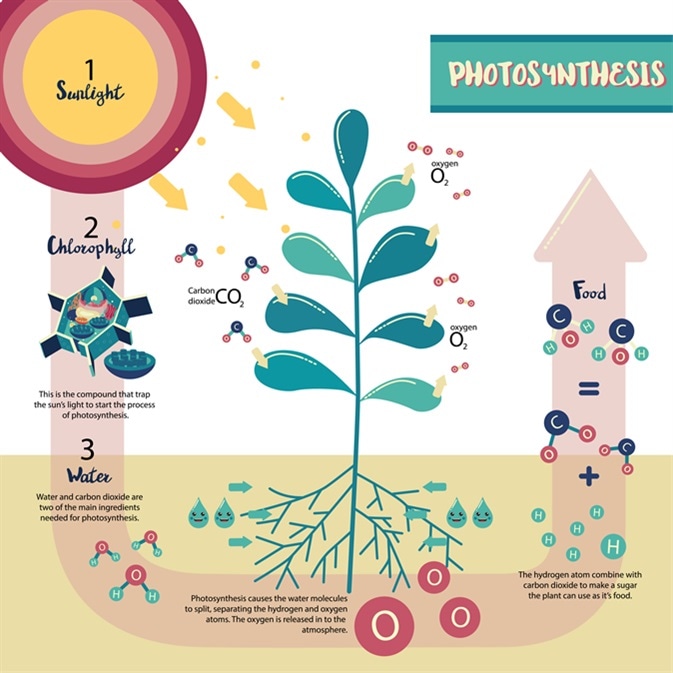Hi!
This may be basic for some but I wanted to try and break down in simple terms how plants get nourished and why the delivery method is how it is. We are going to talk about the the 4 fundamental things plants need for growth and survival. Minerals, Water, Sunlight, and CO2... We'll also talk a bit about Chlorophyll.
In a natual setting(in nature like on a hike) you will most likely see plants growing all around, some form or another. While different plants evolved and adapted to different climates(for example..deserts/rain-forests) they all still need the basics in some degree.
MInerals: Naturally minerals come from different sources, too many to name here, however some of the more recognizable sources may be from a giant boulder that is slowly being eroded by time and weather, the circle of life..aka..plant or animal dies, bacteria break down the organic matter, minerals that are left over slowly become a part of the soil again. Seems pretty easy right? Ok, now that you got that, for our purposes, we are going to be more concerned with the minerals that are water soluble, also referred to as "mineral salts" kinda like that "Pink Himalayan Sea Salt" that someone you know uses for cooking(its supposed to be really good for you!!). Notable mineral salts are nitrogen, phosphorus, potassium, calcium, iron, copper, zinc, boron, manganese, and magnesium. These are the building blocks for all plant life, at least in some variation, and its not an exhaustive list. A grapevine for example requires 16 different trace elements to survive and make that grape so we can have delicious wine. Mineral, mineral salts, elements/trace elements for our purposes are all the same. Means the same thing, just different words, maybe you have wondered what the difference is between trace element and mineral... basically nothing. Glad we cleared that up. If you actually want to know how those words are different go to school for 6+ years and become a scientist otherwise we're just trying to grow something in our backyard or home.
Water: This is an easy one. So in the minerals section we talked about we need minerals that are water soluble. This is important because water is the delivery vehicle for the minerals. Through the roots of plants. The minerals now in the water are in such a small form that the tiny roots or hair looking parts of roots can take it up through a process called osmosis... or simply absorption, you may also hear the word "up-take".. they all mean the same thing.
CO2: For plants, CO2 is essential in the production of glucose, which is a form of sugar. Glucose is the plants food. I know that sounds a bit weird but one of the remarkable things plants do is they technically manufacture their own food. The minerals and CO2 aren't food, that's just like I said earlier, the building blocks. If you're a workout person you may understand this analogy, its like creatine, it helps your body make the stuff to make your muscles big and strong. CO2 is absorbed through the plants "stomata" or tiny pores usually located on the underside of the plants leaves. This is where the plant inhales and exhales both CO2 and oxygen.
Chlorophyll: Don't need to add it, plants come equipped. Chlorophyll is the central substance for photosynthesis to occur, only plants have it. Photosynthesis is the common name for the process of a plant creating food and energy for itself.
Sunlight: Easy one again. The one ingredient to rule them all... absolutely essential for a plant to make its food, the "photo" in photosynthesis. With CO2, minerals, and water; sunlight and chlorophyll provide the engine for glucose production.

So we as humans eat food and our bodies convert it into new cells and energy. Plants do not do this. They use photosynthesis to produce their own food. The food manufacturing process happens during the day while it get sun. then at night the plants distribute the glucose to the parts of the plant that need to grow ie. roots, leaves, stalks, berries, buds, etc. so it can get bigger and ultimately reproduce(in most cases).
Why all this is important is because with hydroponic growing, you can precisely control all of those things to grow a plant exactly the way you want to. Whether its tomatoes, marijuana, kale, basil, flowers, or whatever. And.. you aren't constrained to the limitations of time of day, region, or climate. You are in total control. What's cool about that is that you know EXACTLY what is in the food you are growing, or what you are putting in your body, or giving/selling to others.
Cheers!! I hope this helps... I'll try to post more of these as we go!! -Nat